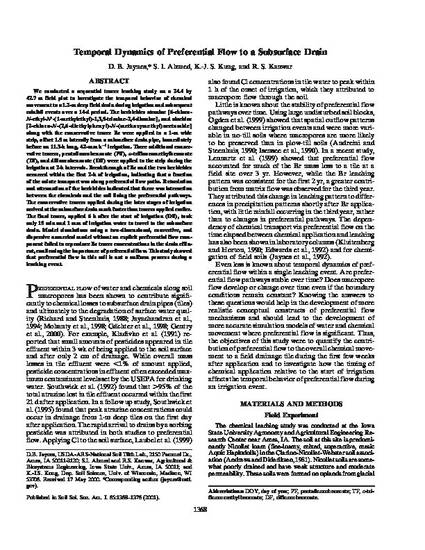
We conducted a sequential tracer leaching study on a 24.4 by 42.7 m field plot to investigate the temporal behavior of chemical movement to a 1.2-m deep field drain during irrigation and subsequent rainfall events over a 14-d period. The herbicides atrazine [6-chloroN-ethyl-N′-(1-methylethyl)-1,3,5-triazine-2,4-diamine], and alachlor [2-chloro-N-(2,6-diethylphenyl)-N-(methoxymethyl)acetamide] along with the conservative tracer Br were applied to a 1-m wide strip, offset 1.5 m laterally from a subsurface drain pipe, immediately before an 11.3-h long, 4.2-mm h−1 irrigation. Three additional conservative tracers, pentafluorobenzoate (PF), o-trifluoromethylbenzoate (TF), and difluorobenzoate (DF) were applied to the strip during the irrigation at 2-h intervals. Breakthrough of Br and the two herbicides occurred within the first 2-h of irrigation, indicating that a fraction of the solute transport was along preferential flow paths. Retardation and attenuation of the herbicides indicated that there was interaction between the chemicals and the soil lining the preferential pathways. The conservative tracers applied during the later stages of irrigation arrived at the subsurface drain much faster than tracers applied earlier. The final tracer, applied 6 h after the start of irrigation (DF), took only 15 min and 1 mm of irrigation water to travel to the subsurface drain. Model simulations using a two-dimensional, convective, and dispersive numerical model without an explicit preferential flow component failed to reproduce Br tracer concentrations in the drain effluent, confirming the importance of preferential flow. This study showed that preferential flow in this soil is not a uniform process during a leaching event.
Available at: http://works.bepress.com/rskanwar/78/

This article is from Soil Science Society of America Journal 65 (2001): 1368–1376, doi:10.2136/sssaj2001.6551368x.